Recognizing Mini Strokes in Older Adults: What You Need to Know

If an elderly loved one begins displaying sudden and unusual behaviors—such as slurred speech or unexpected weakness—it could be more than just a passing issue. These could be signs of a transient ischemic attack (TIA), commonly referred to as a “mini stroke.” A TIA happens when there’s a temporary blockage in the brain’s blood supply, typically caused by a blood clot, plaque buildup, or narrowing of arteries.
In seniors, the likelihood of a TIA increases due to age-related health problems. Conditions like atherosclerosis (artery hardening), high blood pressure, elevated cholesterol, diabetes, and even certain medications can all be contributing factors. Lifestyle habits—like smoking, alcohol use, physical inactivity, and being overweight—can further elevate the risk.
Warning Signs You Shouldn’t Ignore
TIAs often precede more serious strokes, making early recognition critical. Symptoms tend to appear suddenly and may include:
-
Numbness or weakness (especially affecting one side of the body)
-
Confusion or difficulty understanding speech
-
Trouble speaking or slurred words
-
Blurred or double vision
-
Balance issues, dizziness, or coordination problems
-
An abrupt, intense headache without an obvious cause
These signs may only last a few minutes to an hour, but they are a medical emergency nonetheless. Immediate attention can prevent permanent damage or a life-threatening stroke from occurring later.
What Happens Next?
If a TIA is suspected, it’s essential to seek urgent care. Doctors often prescribe medications like antiplatelets or blood thinners to minimize the chance of a future stroke. In some cases, further intervention—such as surgery or monitoring of underlying conditions—might be needed.
Equally important are lifestyle adjustments. Quitting smoking, moderating alcohol, increasing physical activity, and following a heart-healthy diet can significantly lower stroke risk.
Early Action Saves Lives
It’s also vital to rule out other possible conditions that can mimic a TIA, such as low blood pressure episodes, migraines, multiple sclerosis, or infections like meningitis. Fast response not only ensures the right diagnosis but also improves the odds of recovery and long-term well-being.
When it comes to mini strokes in the elderly, every moment counts. Learning the signs and acting swiftly could mean the difference between a close call and a catastrophic stroke.